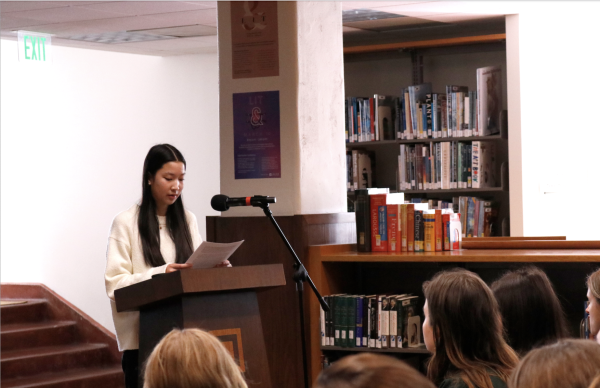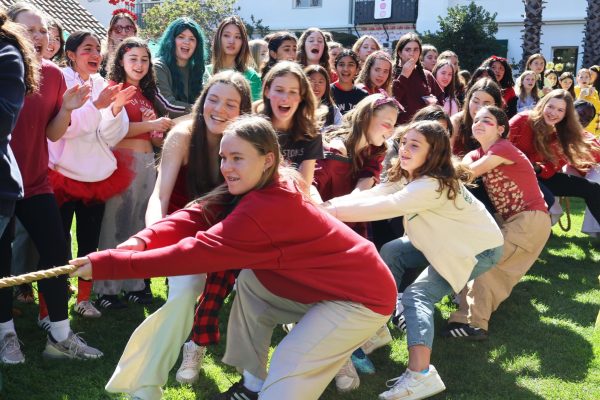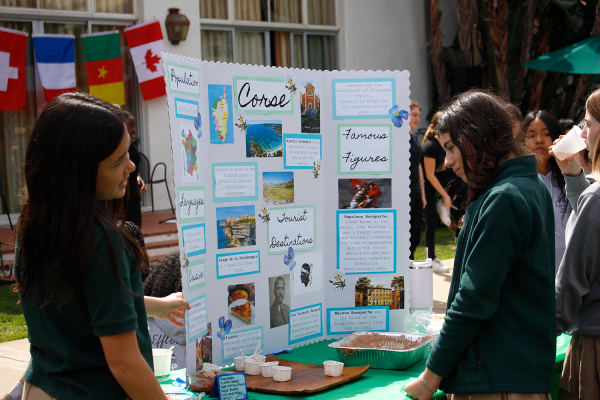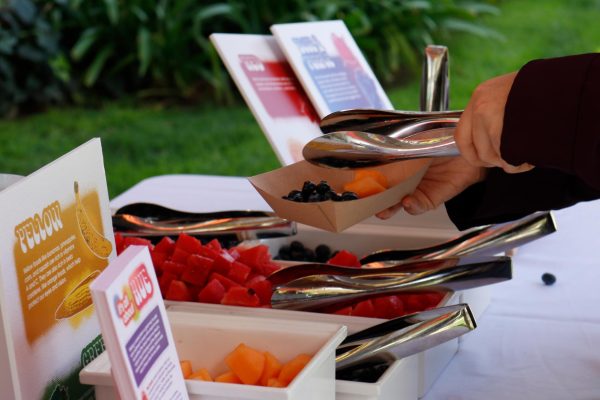STEM Symposium offers platform to discover scientific solutions, explore global problems
Photo credit: Allie Yang
Tess Hubbard (’24) explains InvenTeam’s outreach strategies of connecting with local and digital audiences. The team presented on campus to parents, students and teachers during the STEM Symposium’s third breakout session presentation.
May 23, 2023
From molecular biology to biochemistry, students from nine schools across Los Angeles presented scientific research to parents, students, teachers and judges at Archer’s annual STEM Symposium. The event took place Saturday, May 20, from 9 a.m. – 12:15 p.m. at Archer. Out of the 54 student presenters, 24 attend Archer. The symposium consisted of 33 individual and nine group projects.
This year was senior Zoe Griffin’s second time participating in the symposium after joining the science fair FLX Block. Her project investigated if putting hygroscopic materials in soil would aid moisture and plant growth. She said many other students participated in both the FLX Block and STEM Symposium.
“Everyone who does [the] science fair is offered the STEM Symposium — it’s whether or not they want to take the opportunity,” Griffin said. “The group thinned out a little bit, but for the most part, everybody wanted to.”
The symposium began with two poster sessions in the Zeller Student Center, where groups created boards to display and discuss their hypotheses, procedures and data. From there, spectators attended three breakout session presentations, each of which had time for a Q&A. Lastly, everyone gathered in the library for a keynote address by Cedars-Sinai Vice President and Chief Health Equity Officer Dr. Christina Harris and an awards ceremony.
Flintridge Sacred Heart student Kirthana Senthil (’23) worked with fellow seniors and classmates Kana Park and Sarah Choi to create The ZZZleep Mask. The mask tracks image brightness values and eye movement data to determine if people are experiencing REM sleep. Senthil said the symposium let her group learn about others’ perceptions of their project.
“It’s pretty amazing because there’s no initial bias,” Senthil said. “No one knows about our project. It’s a very eye-opening and fresh experience because we can hear other people’s input [about] a topic they might not know about.”
Science teacher and STEM Coordinator Jerilyn Neshek took the lead in organizing the event by advertising it to schools throughout Los Angeles. In addition, she announced the recipients of Archer’s RISE Award: Flintridge Sacred Heart Academy seniors Amy Chen and Samantha Savage. Their experiment found resveratrol to be an effective biofilm inhibitor and treatment for biofilm infections.
The award recognizes a project that gives provides a solution to a scientific problem. In addition to the RISE Award, the STEM Symposium also offered two Scientific Research Awards and two Engineering and Technology Awards. Neshek said while science can be an independent discipline, the symposium aims to be a forum for the exchange of ideas.
“Science can be hard because you’re by yourself doing your procedure, going through the experiment and finding results,” Neshek said. “Those results could be really cool and need to be showcased. This provides an opportunity for students to showcase their work and be recognized.”
Skylar Roberts (’26) joined the science fair FLX Block and tested a paramagnetic fluid’s effectiveness in removing microplastics from water. She said her project was time-consuming, as initial experimental trials took hours to conduct. Despite this challenge, she said she saw the potential for her and others’ work to have a lasting impact, which compelled her to participate in the symposium.
“In science, it’s fun but also important to look at other people’s results. Even if you aren’t a scientist, science is part of our everyday lives and it’s helping come up with solutions to problems,” Roberts said. “Being able to see the work other people have done and how they solve problems in the world is really interesting and eye-opening.”
NASA mechatronics engineer and Archer alum Brooklin Cohen (’14) was one of six judges to decide the award recipients. Neshek said Cohen’s journey could serve as inspiration for current symposium participants.
“We are training the future scientists and engineers who are going to do something absolutely incredible in the future,” Neshek said. “You can take, for example, our judge Brooklin Cohen. She was highly involved in the engineering program at Archer and is designing for the Mars Perseverance rover. If that’s not changing the world, I don’t know what is.”





![Freshman Milan Earl and sophomore Lucy Kaplan sit with their grandparents at Archer’s annual Grandparents and Special Friends Day Friday, March 15. The event took place over three 75-minute sessions. “[I hope my grandparents] gain an understanding about what I do, Kaplan said, because I know they ask a lot of questions and can sort of see what I do in school and what the experience is like to be here.](https://archeroracle.org/wp-content/uploads/2024/03/grandparents-day-option-2-1200x800.jpg)
















































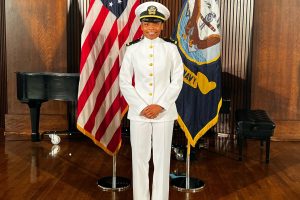






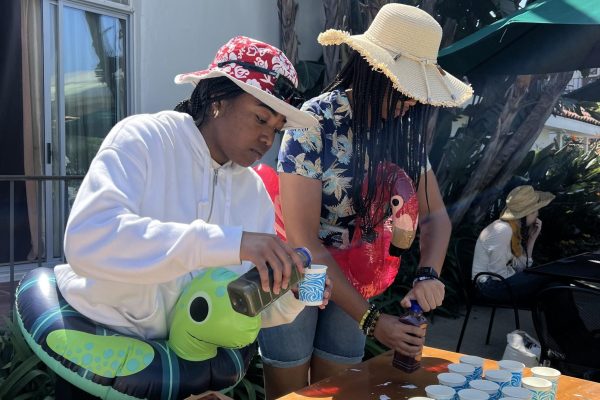
![Freshman Milan Earl and sophomore Lucy Kaplan sit with their grandparents at Archer’s annual Grandparents and Special Friends Day Friday, March 15. The event took place over three 75-minute sessions. “[I hope my grandparents] gain an understanding about what I do, Kaplan said, because I know they ask a lot of questions and can sort of see what I do in school and what the experience is like to be here.](https://archeroracle.org/wp-content/uploads/2024/03/grandparents-day-option-2-600x400.jpg)
